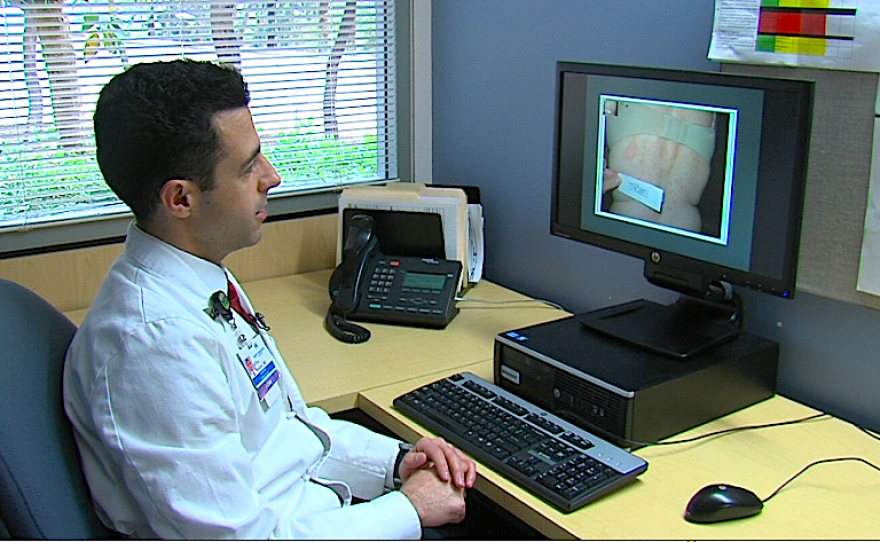Brenda Keagy has a history of skin cancer, so when she spotted something that looked suspicious recently, she wanted to see her dermatologist.
It would have taken more than a month to get an appointment, so she emailed him.
“And he emailed back and asked me if I could send a photograph of the item and attach it to the email system through Kaiser.org," Keagy recalled. "So I did that, and he was able to respond back to me with what the next step was.”
It turned out that Keagy’s skin lesion was cancerous. So her dermatologist had her come into the office so he could remove it.
But after a few days, Keagy was worried that it wasn’t healing properly.
“So, I sent him a photograph of the spot, he looked at it, I had to explain to him in the email what I was experiencing," she said. "He told me it was quite normal, it was healing just perfectly, and if I had any concerns after another week or two to let him know.”
Teledermatology was introduced about 20 years ago. It was originally designed as a way to provide dermatology screenings for people who lived in rural areas, far away from specialists.
Today, it’s used in both urban and rural settings.
Kaiser has the nation’s most robust program.
Primary care doctors initiate the vast majority of Kaiser’s teledermatology services.
When doctors find a questionable skin problem, they have one of their staff take pictures of it.
The photos are sent directly to a dermatologist.
Primary care doctor Martin Bartolac said it’s a very useful tool.
“Even though it takes a little bit more time for us to do it, we get almost immediate feedback to our patients with a question," he explained. "Our patients love it. They think it’s a great service, and we don’t disagree. We think it is a great service for our physicians because we learn quite a lot, every time this happens, as well.”
About 800 Kaiser patients in San Diego use the service each month.
Kaiser dermatologists screen the photos as part of their daily routine. The photos are attached to a patient’s medical record.
Dr. Jeffrey Benabio looks at one image, that shows a patch of skin that looks like it came from a brown snake.
“So this is the kind of thing where I would actually write back to the primary care physician and say that, unfortunately, is a melanoma skin cancer," he explained, "and what we need to do is to have that patient to come in to see us right away, so we can do surgery to remove it.”
In other cases, Dr. Benabio may spot something that looks serious, but is just a common rash.
He said teledermatology allows him to spend the majority of his time on patients who need to be seen in person.
“Those patients who didn’t actually need to come in, who are quite satisfied with just getting their problem fixed, that saves me a visit, so that I’m allowed and able to do these other things, where really, I’m much more valuable," Benabio explained. "It’s much more important that I do that.”
But not all dermatologists are convinced that teledermatology is ready for prime time.
UC San Diego’s Dr. Casey Carlos said primary care doctors don’t always take a picture of the worst lesion on patients.
“And so they did a study at the VA, where basically they took a photo of what that primary care physician was worried about, and less than half of the time was that the most worrisome thing on the patient’s body," Carlos said. "So, once they were actually sent in, and evaluated by dermatologists, they found melanomas, or sequim-cell carcinomas, and other places that may not have been identified as that worrisome lesion that they took the picture of.”
What’s more, Carlos said taking pictures of isolated lesions or moles just can’t compare to an in-person, full-body exam.
“A good dermatologist should be looking through your hair, looking in your genitalia area, looking in private areas, looking between your toes, in areas that I think it would be really hard to get a good image, with either a camera, or even a video camera at this point,” she said.
Studies comparing teledermatology with in-person visits come down on both sides of the fence.
Some show teledermatology is just as accurate as face-to-face appointments, while other research finds just the opposite.
Dr. Benabio maintains teledermatology is an effective way to screen and diagnose patients. And he said at Kaiser, they take steps to make sure they get it right.
For example, Benabio said for most health problems, only one doctor sees a patient.
“But in telederm, here in San Diego, when you send a photo, actually every photo for which we don’t actually see the patient, a second dermatologist reviews it, because it’s so quick," he said. "So it’s a quality assurance that’s built in, and so that’s fantastic, because we’re in some ways higher quality than you would be if you were doing it in person.”
As more Americans get healthcare through the Affordable Care Act, the demand for dermatologists will likely go up.
Teledermatology is one way to broaden access. At the very least, it could save patients a lot of wait time.






